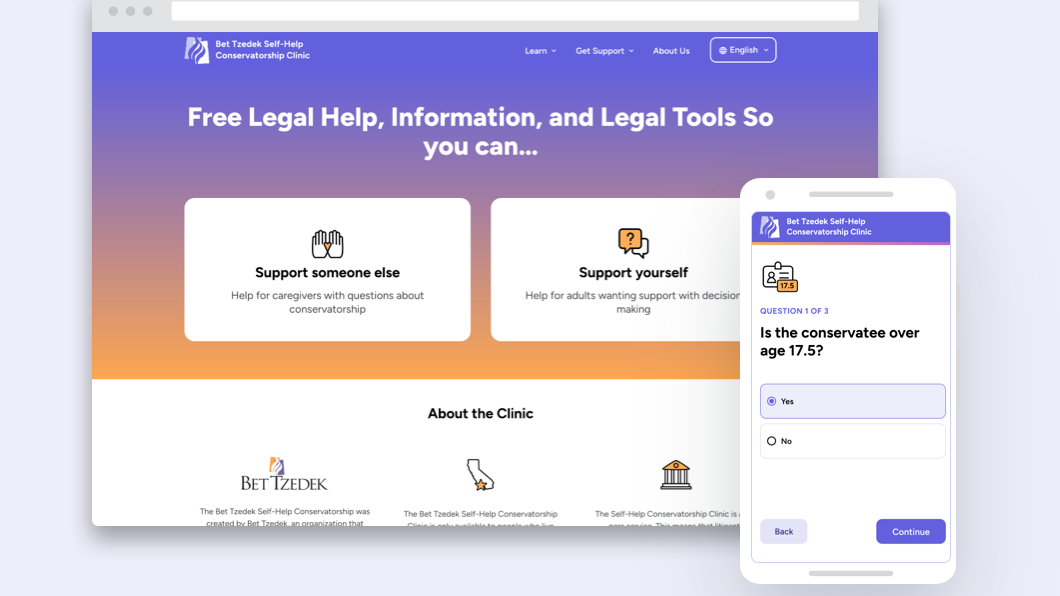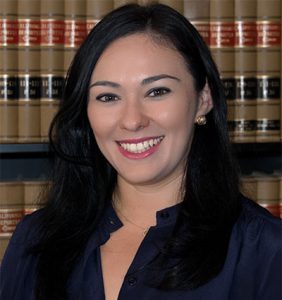In Los Angeles, the legal services organization Bet Tzedek has long run regular in-person legal clinics designed to help self-represented individuals better understand and navigate the sometimes complex process of conservatorship, by which a court appoints a person to manage the personal and financial affairs of someone who cannot make decisions for themself because of an illness or disability.
But the effectiveness of these clinics was sometimes hampered by their congestion. So many people would come seeking general legal information that the lawyers would not be able to get to all the people who had come specifically for conservatorship help.
In addition, Bet Tzedek was aware that, for the population it serves, just getting to the clinic could be a burden. For many, it required them to take time off work or line up a care giver and then arrange transpiration to make the trip downtown or pay the expensive parking fees.
In the belief that technology could help them more effectively meet the needs of self-represented individuals in conservatorship matters, Bet Tzedek partnered with the legal technology design and development firm Theory and Principle to create an online alternative to its in-person clinics.
In January, that partnership resulted in the launch of Bet Tzedek’s Self-Help Conservatorship Clinic website, designed to provide Los Angeles residents with round-the-clock access to information on understanding conservatorships and their alternatives, and the process for obtaining them.
“This site showcases the importance of investing in infrastructure to combat the justice gap,” said attorney Bertha Sanchez Hayden, who heads up Bet Tzedek’s direct services for seniors, dependent adults and caregivers.
“Self help programs are a vital component of increasing access to justice and this platform creates a new space for us to connect with individuals and community partners.”
Funded through a state partnership grant, the clinic reflects a post-COVID acknowledgment of the critical need for legal aid infrastructures that extend beyond traditional in-person resources, Hayden told me in an interview. By leveraging technology, the clinic aspires to enhance efficiency, extend its reach, and provide a replicable model for other legal aid organizations facing similar challenges.
“What we’re offering are really clear and organized paths to information and also to connect with services,” Hayden said.
Resources and Support
The site is organized under two primary topics, “Learn” and “Get Support.” The Learn section provides an overview of conservatorships and its various forms in California. (Conservatorship laws vary by state.) It also provides information on alternatives to conservatorship, such as powers of attorney and advanced health care directives.
The Get Support section walks a user through the process of seeking a conservatorship, providing the necessary forms, instructions on how to file and serve them, and information on preparing for and attending the court hearing.
Everything on the site can be accessed in either English or Spanish, with translation services having been provided by the company Transcend Translations.
Hayden said the online clinic is not a replacement for its in-person clinics in all cases. But for individuals who are comfortable with computers, it provides them a different pathway to access services.
And for the small team of legal professionals Hayden manages, it enables them to be more efficient and serve more people.
“We’re a small team; it’s hard for us to keep up with peoples’ needs in real time,” she said. “That’s been very challenging given how many inquiries we get. So we definitely want to use technology to be more efficient on our side.”
A Model for Others
Although the site was developed to serve individuals in Los Angeles County and its court forms are specific to L.A. courts, its general learning materials are applicable statewide.
Beyond that, Hayden hopes the site will serve as a model that other legal aid or self-help organizations can replicate. That includes the site’s specific materials and instructions, which, Hayden said, required a lot of work to put in plain language and make understandable.
“I can’t tell you how many times I tried to come up with an effective way to explain ‘notice’ to people,” she said. “It sounds like the easiest thing, but try telling somebody they have to mail something to someone that’s in their house, or to their child that’s 13, or to some relatives that live in another country.”
Although there are a multitude of self-help legal websites developed by courts, legal aid organizations, and others, Hayden believes this is the first that sought to replicate the ecosystem of a specific in-person clinic through an online website.
“We’re trying to replicate the experience of when somebody would come to our clinic and say, ‘I need a conservatorship,’ without even understanding what that meant, and we’d say, ‘Did you realize you could do that with a power of attorney? Let’s make it easy for you, let’s print out the form you need.'”
“We’ve built it. We hope it works. Our success is not in people being appointed conservators. Our success is in people understanding the legal process, the legal options they have, the visibility to easier legal options. And then, if they do file for conservatorship, that they feel confident and understand this very technical and arduous court process.”
 Robert Ambrogi Blog
Robert Ambrogi Blog
